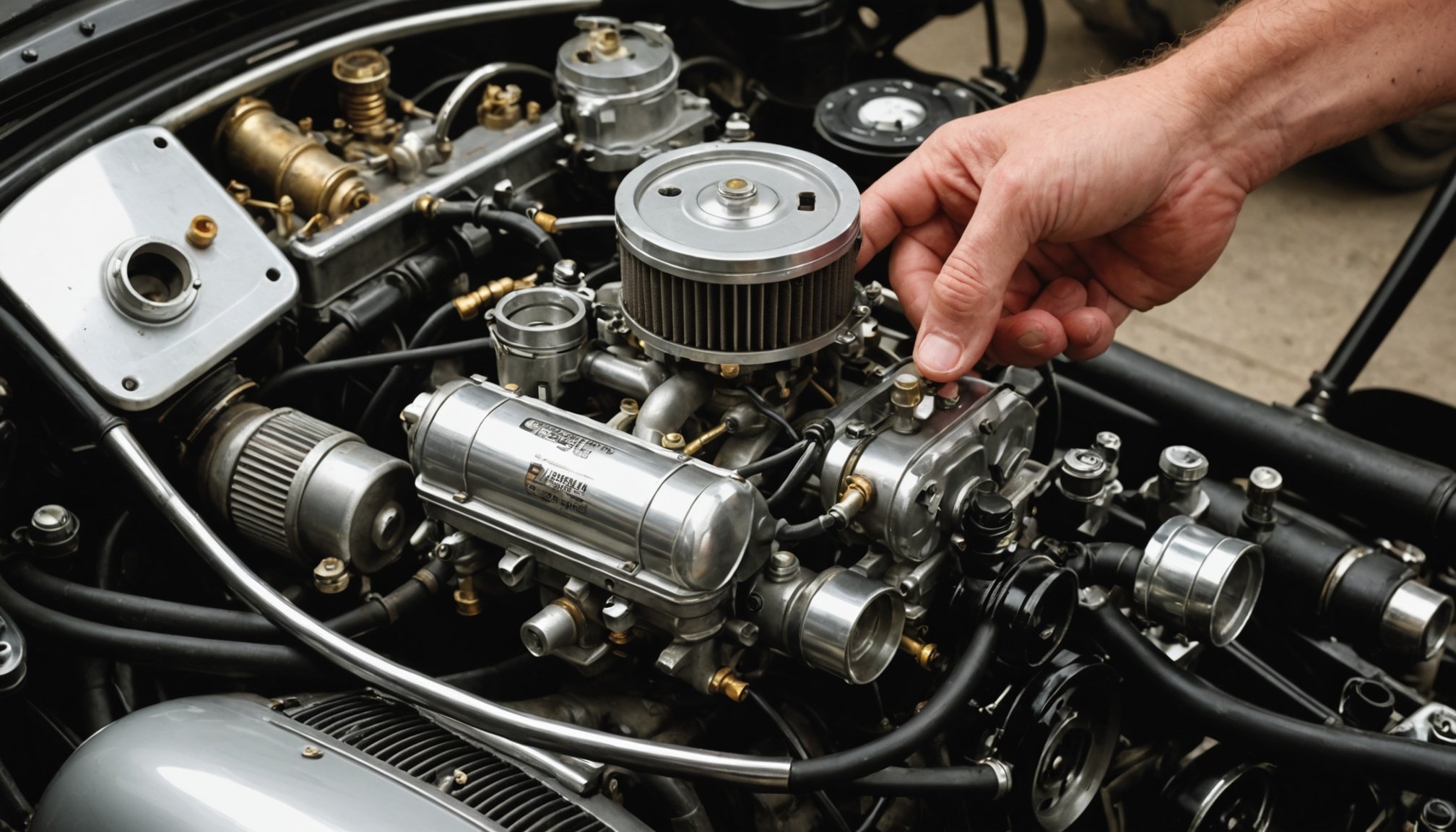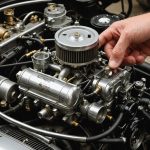Overview of Carburetor Functionality
Understanding carburetor operation is crucial for motorcycle enthusiasts and mechanics alike. The primary function of a carburetor is to mix air with fuel in the appropriate ratio for combustion in the engine. This delicate balance is vital, as an incorrect mixture can lead to either too rich or too lean conditions, affecting performance and fuel efficiency.
The Kawasaki KZ1000 carburetor system exemplifies precision in motorcycle engineering. This model relies on the meticulous tuning of its carburetors to achieve optimal engine performance. Factors such as air temperature, humidity, and altitude can influence carburetor efficiency, necessitating regular adjustments. Tuning involves calibrating aspects like the air-fuel mixture, idle speed, and throttle response, ensuring the engine runs smoothly.
Also read : Essential Steps and Tips for Replacing the Steering Damper on Your Honda VTR1000F: A Comprehensive Guide
A well-maintained carburetor system ensures that the Kawasaki KZ1000 operates at its best, enhancing both speed and fuel economy. Regular maintenance and careful adjustments can prevent common issues such as hesitation or stalling. By mastering the intricacies of carburetor adjustment, riders can enjoy a more responsive and powerful ride, reflecting the engineering prowess behind the KZ1000. Understanding the basics of carburetor operation thus empowers owners to maintain and enhance the longevity of their motorcycles.
Tools Required for Cleaning and Tuning
When it comes to carburetor maintenance, having the right tools can make all the difference in the process of cleaning and tuning. A well-organized toolkit should firstly include a carburetor cleaner to remove dirt and grime efficiently. Specialised screwdrivers and wrenches designed for carburetor adjustment are essential repair tools. These ensure precise adjustments are made without damaging the fragile components of the carburetor.
Also to see : Essential Tips for Caring for the Belt Drive System of Your Harley-Davidson Softail Slim
For more advanced maintenance, a vacuum gauge can be incredibly valuable in ensuring the carburetor is tuned optimally. Needle-nose pliers can serve multiple functions, from handling small parts to unscrewing tight components.
Should you find yourself without some specific tools, consider alternative tools such as dental picks for intricate cleaning or a magnetized socket set for ease in handling small nuts and bolts. Organization of these tools helps in maintaining efficiency and safety in your workspace. Invest in a good quality tool chest or pegboard to keep everything in its place.
Practising safety measures like wearing gloves and goggles is key to preventing injury. By keeping both your tools and safety gear handy, you’ll ensure a smooth, efficient carburetor maintenance process.
Step-by-Step Cleaning Process
Cleaning a carburetor is crucial for the maintenance and efficiency of an engine. To ensure an effective process, careful disassembly, thorough cleaning, and precise reassembly are vital.
Disassembling the Carburetor
Begin by disconnecting the fuel line and removing any attached cables. Using the appropriate tools, gently unscrew and separate the component parts. This precision in disassembly ensures that no piece is damaged, maintaining carburetor integrity for later reassembly. Label each piece or take photos throughout; this will aid in reversing the process.
Cleaning Components Effectively
Once disassembled, immerse the parts in a specialized cleaning solution, designed for breaking down residue without causing harm. Using a soft brush, scrub away debris or build-up on the jets, float chamber, and other components. For tougher grime, ultra-sonic cleaners are recommended as they offer deep-cleaning capabilities. These cleaning techniques preserve the carburetor’s longevity.
Reassembling the Carburetor
With all components cleaned and dried, begin reassembling, ensuring each gasket and seal is replaced. Tighten screws evenly to maintain pressure balance and prevent fuel leaks. A trial run after reassembly is advisable to confirm the engine runs smoothly, marking the success of your maintenance steps.
Tuning the Carburetors for Optimal Performance
Proper tuning techniques play a crucial role in maintaining engine efficiency. Carburetor adjustments involve various steps to enhance overall performance and reliability in engines, particularly for older models.
Setting Idle Speed and Mixture
Achieving the optimal idle speed and mixture is essential for smooth performance. Many rely on adjusting idle mixture screws to find the right balance between fuel and air. Start by turning each mixture screw slowly until the engine runs steadily. Use a tachometer to ensure the idle speed aligns with manufacturer specifications, typically around 600-900 RPM.
Adjusting Float Levels
Accurate float levels are vital for optimal fuel delivery. To adjust, remove the carburetor and examine the float in the bowl. The float should rest parallel to the carburetor body when held upside down. If misaligned, gently bend the float tab to achieve the correct position, ensuring consistent fuel levels.
Synchronizing Carburetors
For multi-carb setups, synchronization ensures balanced operation. Use a synchronizing tool to measure airflow across each carburetor. Adjust the linkage between them for equal flow, enhancing engine performance and efficiency. Prioritize synchronization to prevent imbalances and engine misfires.
Troubleshooting Common Carburetor Issues
Understanding carburetor problems is essential for maintaining your vehicle’s performance. Recognizing symptoms like poor fuel economy, engine misfires, or hard starting can indicate carburetor issues. First, examine the air-fuel mixture. If it’s too rich or lean, this could lead to performance issues.
Quick diagnostic tips can save time and money. Start by inspecting the air filter; a clogged filter restricts air flow, contributing to carburetor problems. Check for vacuum leaks by listening for a hissing sound around the carburetor connections. A simple technique is using carburetor cleaner to detect leaks; a change in engine RPM suggests a vacuum issue.
Solving frequent problems often requires cleaning or rebuilding the carburetor. For issues like rough idle or stalling, ensure screws on the carburetor are tightened correctly. If the engine surges or hesitates, clean the jets and passages of the carburetor. Diagnostic tips also include adjusting the idle speed and mixture screws based on the manufacturer’s settings.
Being proactive with these solutions helps maintain optimal engine performance. Regular maintenance avoids complex repairs, ensuring your vehicle runs smoothly. Proper understanding and application of these tips are crucial for any vehicle owner.
Maintenance Tips for Longevity
Maintaining a carburetor involves several key practices to ensure its optimal performance. Establishing a routine maintenance schedule is vital. Regular inspections should include cleaning and adjusting carburetor components to avoid clogs and ensure efficient functioning. Preventative care is crucial in preventing severe issues that may necessitate costly repairs or replacements.
An important aspect of preventative care is identifying signs of wear. Scrutinize for indications such as frequent engine misfires or unusual fuel consumption, which may signal the need for parts replacement. Replacing worn-out components promptly can mitigate extensive damage and prolong the life of the carburetor.
To preserve the condition of the carburetor, consider these performance upkeep tips:
- Ensure fuel filters are clean and in good condition to prevent contaminants from entering the carburetor.
- Regularly check for fuel leaks and promptly address any discovered issues.
- Use fuel additives that help to clean internal components, enhancing carburetor efficiency.
Overall, incorporating carburetor maintenance into your routine can significantly enhance its longevity and performance, ensuring that your machinery continues to operate efficiently over time. Prioritize these actions to minimize long-term issues and maintenance costs.
Frequently Asked Questions
Curious about commonly asked questions regarding carburetor cleaning and tuning? Let’s tackle some of these queries to ease any uncertainties.
How do I clean a carburetor effectively?
The key to a thorough cleaning is dismantling the carburetor. Use carburetor cleaner sprays, ensuring that all passageways are free from debris. Regular cleaning prevents clogs and maintains optimal performance.
What are typical signs my carburetor needs tuning?
If you notice engine performance issues, such as stalling or inconsistent idling, it might indicate the need for tuning. Tuning ensures the air-fuel mixture is balanced, crucial for efficient operation.
Are there misconceptions about carburetor maintenance?
Indeed! A common myth is that carburetors need constant adjustments – but most require only periodic cleaning and timely tuning based on engine performance.
Quick tips for troubleshooting queries:
- Engine stalling: Check for fuel flow issues.
- Difficulty starting: Inspect the choke and idle settings.
- Poor fuel economy: Ensure the right air-fuel ratio.
Feel empowered to tackle these carburetor challenges with this quick reference. Understanding these fundamentals aids in maintaining your engine’s health and performance.











